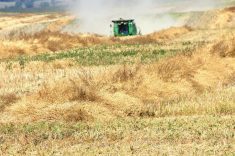WINNIPEG – Farmers can’t escape wheat midge by seeding later than usual, according to a Saskatoon research scientist with Agriculture Canada.
Even though farmers may have planted wheat a few weeks later than previous years, Owen Olfert said it is false security to believe the midge will hatch before wheat gets to the heading stage.
“The development of the wheat midge is synchronized very closely to that of wheat,” Olfert said, explaining that both depend on heat to mature.
The only way farmers might beat midge is to plant in late June. But Olfert said they would risk a killing frost in the fall.
Read Also

Alberta researcher helps unlock the economics of farming
Lethbridge Polytechnic researcher helping agriculture producers with decision-making tools in economic feasibility
Olfert uses a mathematical calculation to measure heat units by the day. An area will collect heat units when its daytime high is above five degrees Celsius. The higher the temperature, the more heat units accumulate.
For example, Olfert said the Saskatoon area had accumulated just over 200 heat units by June 6, while Winnipeg was about a week’s worth of units cooler at 190.
Wheat midge will begin to emerge around the 660-unit mark. Olfert said it’s hard to predict when this will happen because it depends on daily maximum temperatures.
Agriculture Canada will issue a map and warnings when at least one region has had enough heat for midges to emerge.
According to a wheat midge cocoon count in the fall of 1995, the insect has spread and multiplied during the past few years.
In fact, Agriculture Canada expects some severe infestations around Winnipeg, Brandon, Melville, Weyburn, and in a wide area between Regina and Saskatoon.
Farmers in infested areas should monitor wheat fields from the time the head emerges from the boot until flowering. Agriculture Canada recommends an insecticide be applied when the crop is heading and there is at least one adult midge on every four to five wheat heads.














